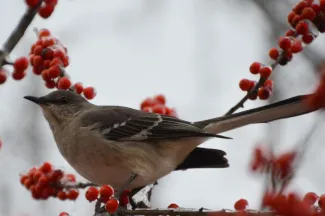A dual-purpose wildlife plant, winterberry offers a late season treat to many species of wildlife during winter and is a great hiding spot for bird nests in the spring. The red berries also supply a welcome splash of color to Oklahoma’s winter landscape.
Native plants are a great way to attract wildlife to your property, but it can sometimes be a challenge to find plants that benefit wildlife in multiple ways and add color to your backyard year-round. With clusters of bright red berries enticing songbirds in the winter and dark green leaves providing cover in the spring and summer, winterberry (also known as deciduous holly or possumhaw holly) may provide the right mix of beauty and practicality.

These shrubs can reach 20 feet in height and are often found near small streams in the eastern-third of the state. Even so, they have been widely used in landscaping efforts and do well when planted in almost any kind of soil. Green, oval leaves with finely-toothed edges alternate on the gray twigs. Winterberries have both male and female plants, a feature shared by others in the holly family.
While the fruit-producing female winterberry is more popular in the landscape trade, one male plant is needed for every 4-6 female plants to ensure fruit-set.
Enhance Your Winterberry Wildscape with These Perennials
Several native plants pair well with winterberry, but Wildlife Diversity Program biologists suggest native flowering perennials that provide additional wildlife benefits. In shaded areas, spring perennials like coral bells, spiderworts and woodland phlox will attract hummingbirds, butterflies and other insects that may help pollinate the shrub. If the winterberry is in a sunny area, summer perennials like purple coneflower, brown-eyed susans and prairie phlox will help attract butterflies and other wildlife to your property before the winterberry fruit ripens.
Though flowering annuals like Indian blanket and Mexican sunflower are great additions to a wildscape, biologists recommend they be planted several feet away from the shrub if you prefer the shrub’s upright growth form. Winterberry is a root-sprouting plant; when the soil around the shrub is turned over in preparation for new plants it’s a signal for the shrub to send up sprouts. Root-sprouting creates a low-growing shrub with multiple stems at ground level. Though the shrubby form of the winterberry can provide cover for birds and small mammals, it may not be as visually appealing for some homeowners.